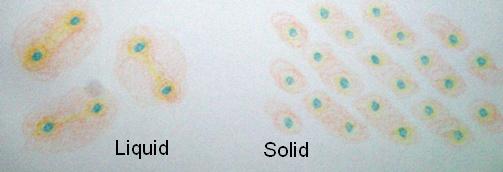Energy
Energy is free fotons moving around.
The constant movement of fotons
Fotons constantly move from matino to matino, and spend time traveling in-between as energy. Free fotons make up the majority of the mass of the universe. The separation between negatini and positini in a foton ranges from less than the diameter of an electron, to as large as the universe. The larger the separation, the lower the frequency of the foton (lower orbiting speed).
Absorption and emission
When a foton is trapped by a matino, it is called absorption. When it is released, it is called emission. (BTW absorption is the noun, absorb is the verb - same meaning) The two fotinis are sometimes absorbed by separate matinos, sometimes by a single matino. A foton is absorbed only by a pair of matinos that match its own orbiting speed and distance. Orbiting matinos release fotons that match their orbit.
In the universe, absorption and emission occur constantly. A stable substance has an equilibrium where absorption and emission are equal.
An analogy
A good analogy for the dynamic situation for a matino is a pond in a creek. Water flows into the pond, and an equal amount flows out - a stable equilibrium. If the dam on a pond collapses, more water is released than added, until a new equilibrium is reached - a new pond water level. It is like an exothermic reaction, releasing energy - increasing the temerature. If the dam height is increased, no water is released until the pond level reaches a new height. Like an exothermic reaction, absorbing energy - lowering the temperature. It is the pond that is stable, while the water it contains is constantly being replaced.
The fotons that make up any matino are constantly being replaced, it is only the environment of the matino that makes it seem stable.
Changed environment, changed matino size
When an atom changes its environment, the physical size of its subatomic particles changes to maintian a stable system.
For example, an atom is involved in a chemical reaction and encounters a different electromagnetic environment. This new environment affects what makes a stable orbiting system. The atom sheds or adds mass from its matinos in order to adjust to the new situation.
A reaction that releases energy is one that causes the atoms to shed mass as free fotons. Matinos emit fotons at a greater rate than they absorb fotons, until the new equilibrium is reached.
A reaction that absorbs energy is one that causes the atoms to take on mass. Matinos absorb fotons at a greater rate than they emit fotons, until the new equilibrium is reached.
Substance phase changes

When a substance changes from a solid to a liquid, or from a liquid to a gas, it is called a phase change. These changes either release or absorb energy.
The cause of energy movement is a change in the size of electron orbitals.
When a substance condenses from a gas to a liquid, the molecules in the substance become much closer to each other. This causes the electron orbitals to be increasingly influenced by the orbitals of adjacent molecules. This influence directly affects the stable balance of electron orbitals.
In order to re-establish a stable orbital arrangement, the electrons reduce the size of their orbits - by releasing mass in the form of fotons.
When condensation occurs and the electron orbitals are comnpressed, more fotons are emitted than are absorbed, until the electron orbitals find a new balance. Alternatively, when the molecules of a substance have more room to move, the electron orbitals increase their size - by absorbing more fotons then they release. For example, evaporating water absorbs energy and a drop in temperature is observed.
Exothermic and endothermic reactions
Chemical reactions also involve absorbtion or release of energy in the form of fotons. This involves the same principle as substance phase changes. During the reaction, the environment for the electrons changes, and they adjust to a new stable orbit configuration by shedding or absorbing mass in the form of fotons.
